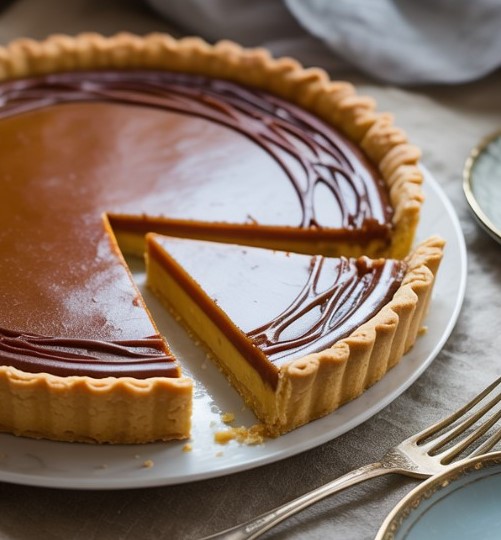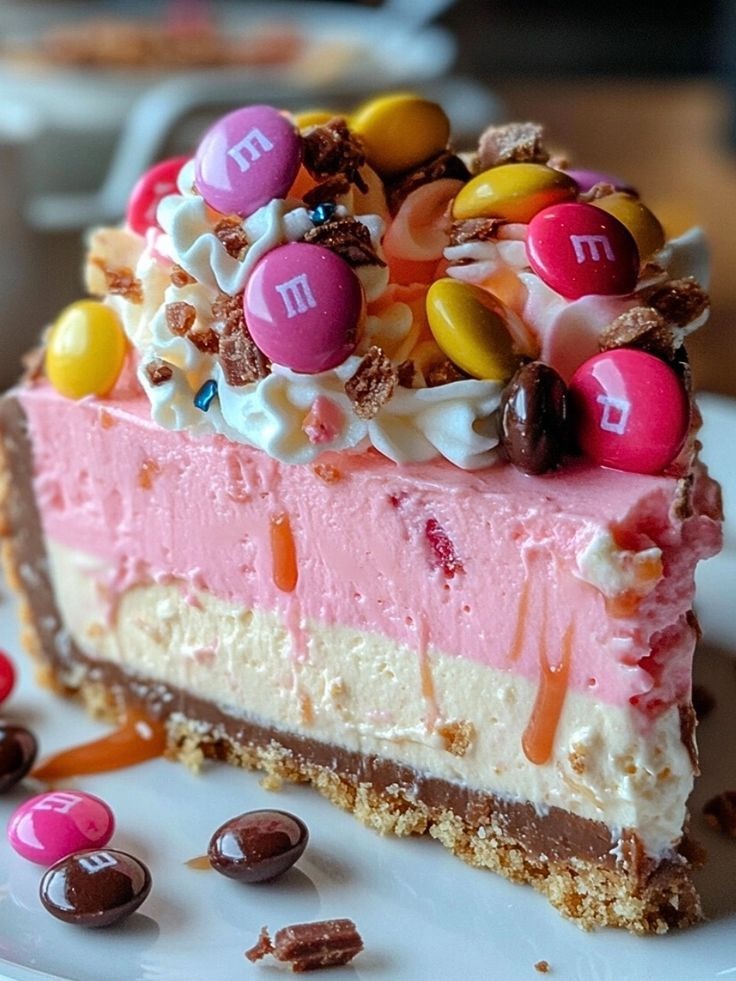I was dusting off an old biscuit tin from my mother’s cupboard—a rusted one with faded roses painted on the lid—when a folded piece of parchment fluttered to the floor. It was a recipe, handwritten in her cursive, slightly smudged with time and sugar. That moment stopped me in my tracks. My mother’s butterscotch tart. A dessert that used to show up magically on rainy Sundays, always just when we needed something cozy and sweet. It was the kind of tart that didn’t shout with extravagance but wrapped you in warmth with each bite.
Back then, I never gave it much thought. I was too busy licking the spoon and watching raindrops trace rivers down the window. But rediscovering that recipe felt like a quiet whisper from her, and I knew I had to bring it back to life—not just for me, but for the generations who hadn’t yet tasted its charm.
So, I spent a cloudy afternoon recreating it in my kitchen. The scent of bubbling butter and caramelized sugar filled the house, instantly tugging on heartstrings I didn’t know were still so tender. It wasn’t just baking. It was remembering. Rebuilding. Returning.
This tart isn’t flashy. It’s humble, buttery, and melt-in-your-mouth soft with a mellow sweetness that never overwhelms. And now that I’ve adjusted the recipe just slightly to make it easier for modern kitchens—without losing its soul—I’m ready to share it with you.

Short Description
A nostalgic, silky-smooth butterscotch tart with a golden shortcrust pastry base, rich caramel flavor, and a creamy filling—perfectly chilled and served as a classic dessert for any occasion.
Key Ingredients
- Shortcrust pastry: 250g (or store-bought, if preferred)
- Caster sugar: 150g
- Butter: 100g
- Whole milk: 250ml
- Cornflour: 2 tbsp
- Egg: 1, beaten
- Lemon juice (optional): 1 tsp
- Vanilla extract: 1 tsp
Tools Needed
- 23cm tart tin
- Rolling pin
- Baking paper & baking beans (or dry rice)
- Saucepan
- Whisk
- Mixing bowl
- Spatula
- Measuring spoons
Cooking Instructions
Step 1: Prepare the Pastry Base
Preheat your oven to 180°C fan (350°F) and lightly grease a 23cm tart tin. Roll out the shortcrust pastry on a floured surface until it’s a few millimeters thick. Line the tin with the pastry, gently pressing it into the corners. Trim any overhang. Prick the base with a fork. Line it with baking paper and fill with baking beans.
Blind bake for 10–12 minutes, then remove the beans and paper. Bake for 5 more minutes until the crust turns golden and crisp. Set aside to cool.
Step 2: Start the Butterscotch Base
In a saucepan over medium heat, melt the butter and caster sugar, stirring continuously. It’ll start to blend into a smooth amber syrup. Make sure the sugar fully dissolves—this prevents grainy texture.
Step 3: Create the Thickener
In a separate bowl, mix the cornflour with a few tablespoons of cold milk to form a smooth paste. This step is crucial—lumps now mean lumps later!
Step 4: Add Milk and Thicken
Pour the remaining milk into the butter-sugar mixture and stir gently. Then whisk in the cornflour paste, stirring constantly. As the mixture heats, it will thicken—this takes around 5–7 minutes. Once it starts to bubble, cook for 2-3 more minutes, stirring the entire time.
Step 5: Add Final Flavor and Creaminess
Remove from heat. Quickly whisk in the beaten egg, vanilla extract, and lemon juice (if using). The residual heat will cook the egg, creating a luscious, silky texture. Don’t stop whisking until it’s smooth.
Step 6: Fill and Chill
Pour the warm butterscotch filling into the cooled pastry case, smoothing the top with a spatula. Let the tart cool to room temperature, then refrigerate for 2–3 hours, or until fully set.
Step 7: Slice and Serve
Once set, slice with a sharp knife. The tart should hold its shape but melt on the tongue. Serve chilled for the best experience.
Why You’ll Love This Recipe
– Silky smooth filling with rich caramel undertones
– Buttery, crisp shortcrust base
– Nostalgic and comforting
– Simple ingredients, pantry-friendly
– Perfect make-ahead dessert
– Ideal for family gatherings or tea parties
Mistakes to Avoid & Solutions
Lumpy filling? That usually means the cornflour paste wasn’t smooth. Solution: Mix cornflour with cold milk thoroughly—no shortcuts.
Pastry shrinks in the oven? Likely overworked or not chilled. Solution: Let the rolled pastry rest in the tin for 10 minutes before baking.
Grainy texture in the filling? Sugar didn’t dissolve fully. Solution: Melt it slowly and stir continuously before adding milk.
Filling too runny after chilling? It may not have cooked long enough to activate the cornflour. Solution: Ensure it bubbles and thickens before removing from heat.
Egg curdled? It was added while the mixture was too hot. Solution: Let the pan cool slightly and whisk continuously while adding.
Serving and Pairing Suggestions
– Serve chilled with a dollop of whipped cream or a drizzle of cream
– Pair with stewed apples or poached pears for a fruity contrast
– Wonderful alongside hot black tea or a smooth cup of coffee
– Serve family-style at gatherings or plated elegantly with garnish
– Add a sprinkle of sea salt flakes just before serving for a gourmet touch
Storage and Reheating Tips
Store: Cover the tart tightly with plastic wrap and keep it in the fridge for up to 4 days.
Freeze: Slice and freeze in airtight containers for up to 1 month. Thaw overnight in the fridge.
Reheat: Best served cold, but if you prefer warm, heat a slice gently in the microwave for 15–20 seconds—just enough to soften, not melt.
Avoid: Reheating the whole tart—it can ruin the texture.
FAQs
1. Can I make this tart the day before serving?
Yes, in fact it’s better! It sets beautifully overnight and is easier to slice.
2. Can I use plant-based milk instead of whole milk?
Yes. Unsweetened almond or oat milk work well, though the filling may be slightly less rich.
3. What if I don’t have cornflour?
You can use arrowroot or plain flour (use 3 tbsp instead), though the texture will differ slightly.
4. Can I use brown sugar instead of caster sugar?
Yes! It deepens the butterscotch flavor but will also darken the filling.
5. Why is lemon juice optional?
It adds a hint of brightness to cut through the sweetness but isn’t necessary for texture or setting.
Tips & Tricks
Chill your tart base before blind baking to prevent shrinking.
Keep stirring while the filling thickens to prevent it catching at the bottom.
Taste the filling before pouring—it’s your last chance to adjust sweetness or add more vanilla.
To keep your tart edges neat, use a small, serrated knife and wipe it clean after each cut.
Use a pie weight alternative like dry lentils or rice if you don’t have baking beans.
Recipe Variations
Chocolate Butterscotch Tart
Swap out 50g of sugar for 50g melted dark chocolate in the filling. The result is a deeper, fudgy flavor. Follow all other steps the same.
Nutty Caramel Tart
Sprinkle 50g chopped toasted pecans over the crust before pouring in the filling. It adds crunch and richness.
Salted Butterscotch Tart
Stir ½ tsp sea salt into the finished filling before pouring. Garnish with flaky salt before serving for a bold, modern touch.
Dairy-Free Version
Use plant-based butter and oat or almond milk. Replace the egg with 2 tsp cornstarch mixed in 2 tbsp water. The texture will be a bit lighter, but still delicious.
Mini Tarts for Parties
Use mini tart tins or a muffin tray. Cut smaller pastry rounds and bake 5–6 minutes less. They set faster too—great for gatherings!
Final Thoughts
Revisiting this recipe brought more than a dessert to my table—it brought memories, warmth, and a sense of comfort that only food from the past can offer. This butterscotch tart isn’t trying to dazzle with modern flair; it invites you to slow down, stir thoughtfully, and savor each bite.
The beauty lies in its simplicity. No fancy tricks. Just honest ingredients, a touch of patience, and a lot of heart. I hope when you make it, you feel some of that same magic—whether it’s for a quiet evening alone or passed around a busy kitchen full of laughter.
Keep the traditions alive. And don’t forget to tuck your own little recipe into a tin for someone to find one day.

Ingredients
- Shortcrust pastry: 250g (or store-bought, if preferred)
- Caster sugar: 150g
- Butter: 100g
- Whole milk: 250ml
- Cornflour: 2 tbsp
- Egg: 1, beaten
- Lemon juice (optional): 1 tsp
- Vanilla extract: 1 tsp
Instructions
Step 1: Prepare the Pastry Base
Preheat oven to 180°C fan (350°F). Grease a 23cm tart tin. Roll out the pastry, line the tin, trim the edges, and prick the base with a fork. Line with baking paper and fill with baking beans.
Blind bake for 10–12 minutes, then remove the paper and beans. Bake 5 more minutes until golden. Cool completely.
Step 2: Start the Butterscotch Base
Melt butter and sugar in a saucepan over medium heat, stirring until smooth and fully dissolved.
Step 3: Create the Thickener
Mix cornflour with a few tablespoons of cold milk in a bowl until smooth and lump-free.
Step 4: Add Milk and Thicken
Add remaining milk to the saucepan, then whisk in the cornflour paste. Stir constantly until thick and bubbling (5–7 minutes). Cook 2–3 minutes more.
Step 5: Add Final Flavor and Creaminess
Remove from heat. Whisk in the beaten egg, vanilla, and lemon juice (optional) until silky smooth.
Step 6: Fill and Chill
Pour the filling into the cooled pastry case. Smooth the top. Let cool, then refrigerate for 2–3 hours to set.
Step 7: Slice and Serve
Once set, slice cleanly and serve chilled. The tart should be firm but melt-in-your-mouth.


